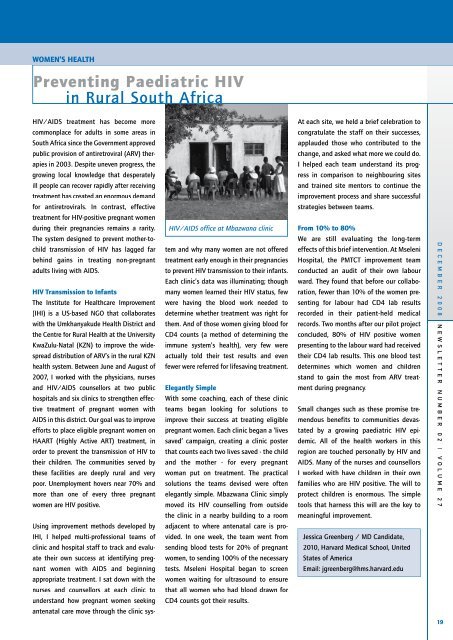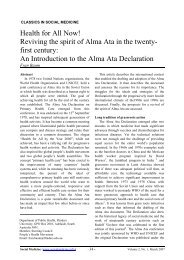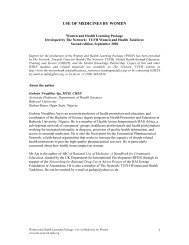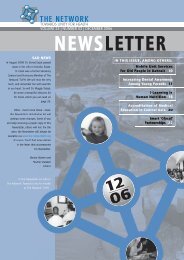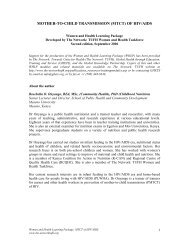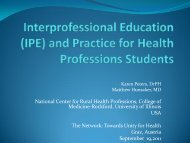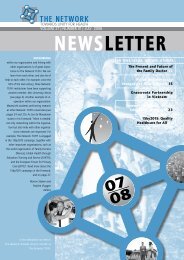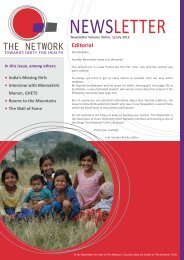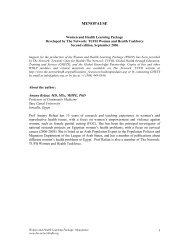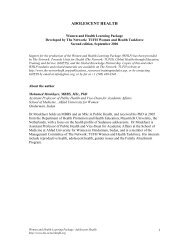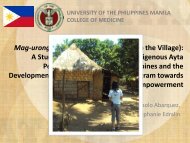The network - Towards Unity For Health
The network - Towards Unity For Health
The network - Towards Unity For Health
You also want an ePaper? Increase the reach of your titles
YUMPU automatically turns print PDFs into web optimized ePapers that Google loves.
WOMEN’S HEALTHPreventing Paediatric HIVin Rural South AfricaHIV/AIDS treatment has become moreAt each site, we held a brief celebration tocommonplace for adults in some areas incongratulate the staff on their successes,South Africa since the Government approvedapplauded those who contributed to thepublic provision of antiretroviral (ARV) ther-change, and asked what more we could do.apies in 2003. Despite uneven progress, theI helped each team understand its prog-growing local knowledge that desperatelyress in comparison to neighbouring sitesill people can recover rapidly after receivingand trained site mentors to continue thetreatment has created an enormous demandimprovement process and share successfulfor antiretrovirals. In contrast, effectivestrategies between teams.treatment for HIV-positive pregnant womenduring their pregnancies remains a rarity.HIV/AIDS office at Mbazwana clinicFrom 10% to 80%<strong>The</strong> system designed to prevent mother-to-We are still evaluating the long-termchild transmission of HIV has lagged farbehind gains in treating non-pregnantadults living with AIDS.HIV Transmission to Infants<strong>The</strong> Institute for <strong>Health</strong>care Improvement(IHI) is a US-based NGO that collaborateswith the Umkhanyakude <strong>Health</strong> District andthe Centre for Rural <strong>Health</strong> at the UniversityKwaZulu-Natal (KZN) to improve the widespreaddistribution of ARV’s in the rural KZNhealth system. Between June and August of2007, I worked with the physicians, nursesand HIV/AIDS counsellors at two publichospitals and six clinics to strengthen effectivetreatment of pregnant women withAIDS in this district. Our goal was to improveefforts to place eligible pregnant women onHAART (Highly Active ART) treatment, inorder to prevent the transmission of HIV totheir children. <strong>The</strong> communities served bythese facilities are deeply rural and verypoor. Unemployment hovers near 70% andmore than one of every three pregnantwomen are HIV positive.tem and why many women are not offeredtreatment early enough in their pregnanciesto prevent HIV transmission to their infants.Each clinic’s data was illuminating; thoughmany women learned their HIV status, fewwere having the blood work needed todetermine whether treatment was right forthem. And of those women giving blood forCD4 counts (a method of determining theimmune system’s health), very few wereactually told their test results and evenfewer were referred for lifesaving treatment.Elegantly SimpleWith some coaching, each of these clinicteams began looking for solutions toimprove their success at treating eligiblepregnant women. Each clinic began a ‘livessaved’ campaign, creating a clinic posterthat counts each two lives saved - the childand the mother - for every pregnantwoman put on treatment. <strong>The</strong> practicalsolutions the teams devised were oftenelegantly simple. Mbazwana Clinic simplymoved its HIV counselling from outsideeffects of this brief intervention. At MseleniHospital, the PMTCT improvement teamconducted an audit of their own labourward. <strong>The</strong>y found that before our collaboration,fewer than 10% of the women presentingfor labour had CD4 lab resultsrecorded in their patient-held medicalrecords. Two months after our pilot projectconcluded, 80% of HIV positive womenpresenting to the labour ward had receivedtheir CD4 lab results. This one blood testdetermines which women and childrenstand to gain the most from ARV treatmentduring pregnancy.Small changes such as these promise tremendousbenefits to communities devastatedby a growing paediatric HIV epidemic.All of the health workers in thisregion are touched personally by HIV andAIDS. Many of the nurses and counsellorsI worked with have children in their ownfamilies who are HIV positive. <strong>The</strong> will toprotect children is enormous. <strong>The</strong> simpletools that harness this will are the key toD E C E M B E R 2 0 0 8 N E W S L E T T E R N U M B E R 0 2 | V O L U M E 2 7the clinic in a nearby building to a roommeaningful improvement.Using improvement methods developed byadjacent to where antenatal care is pro-IHI, I helped multi-professional teams ofvided. In one week, the team went fromJessica Greenberg / MD Candidate,clinic and hospital staff to track and evalu-sending blood tests for 20% of pregnant2010, Harvard Medical School, Unitedate their own success at identifying preg-women, to sending 100% of the necessaryStates of Americanant women with AIDS and beginningtests. Mseleni Hospital began to screenEmail: jgreenberg@hms.harvard.eduappropriate treatment. I sat down with thewomen waiting for ultrasound to ensurenurses and counsellors at each clinic tothat all women who had blood drawn forunderstand how pregnant women seekingCD4 counts got their results.antenatal care move through the clinic sys-19


